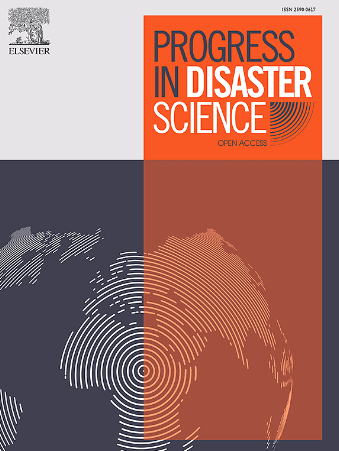Factors associated with household flood preparedness in Songkhla old town Thailand
IF 3.8
Q3 ENVIRONMENTAL SCIENCES
引用次数: 0
Abstract
This study investigates household disaster preparedness in Songkhla Old Town, Thailand, a culturally significant area vulnerable to floods. Using the Protection Motivation Theory framework, we conducted a cross-sectional survey of 450 households to assess preparedness levels and identify associated factors. Our findings revealed that disaster preparedness knowledge emerged as the strongest predictor of household preparedness (β = 0.539, p < 0.001), followed by perceived disaster risk (β = 0.202, p < 0.001) and perceived disaster consequences (β = 0.193, p < 0.001). Community preparedness and support (β = 0.134, p < 0.001) and governmental preparedness (β = 0.126, p = 0.003) also positively influenced preparedness behaviors, while anxiety showed a negative relationship (β = −0.124, p = 0.010). Notably, socio-demographic characteristics did not significantly predict preparedness, suggesting the importance of local cultural and institutional context. These findings underscore the need for multi-faceted interventions integrating individual-level factors like knowledge with community-level factors like social cohesion and governmental support.
泰国宋卡老城与家庭防洪相关的因素
本研究调查了泰国宋卡老城的家庭防灾准备情况,宋卡老城是一个具有重要文化意义的易受洪水影响的地区。利用保护动机理论框架,我们对450个家庭进行了横断面调查,以评估准备水平并确定相关因素。我们的研究结果显示,备灾知识是家庭备灾的最强预测因子(β = 0.539, p <;0.001),其次是感知灾害风险(β = 0.202, p <;0.001)和感知到的灾难后果(β = 0.193, p <;0.001)。社区准备和支持(β = 0.134, p <;0.001)和政府准备(β = 0.126, p = 0.003)对准备行为有正向影响,而焦虑(β = - 0.124, p = 0.010)对准备行为有负向影响。值得注意的是,社会人口特征并不能显著预测准备情况,这表明当地文化和制度背景的重要性。这些发现强调需要采取多方面的干预措施,将个人层面的因素(如知识)与社区层面的因素(如社会凝聚力和政府支持)结合起来。
本文章由计算机程序翻译,如有差异,请以英文原文为准。
求助全文
约1分钟内获得全文
求助全文
来源期刊

Progress in Disaster Science
Social Sciences-Safety Research
CiteScore
14.60
自引率
3.20%
发文量
51
审稿时长
12 weeks
期刊介绍:
Progress in Disaster Science is a Gold Open Access journal focusing on integrating research and policy in disaster research, and publishes original research papers and invited viewpoint articles on disaster risk reduction; response; emergency management and recovery.
A key part of the Journal's Publication output will see key experts invited to assess and comment on the current trends in disaster research, as well as highlight key papers.
 求助内容:
求助内容: 应助结果提醒方式:
应助结果提醒方式:


